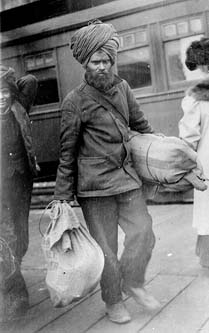Immigration and Exclusion
The first group of Asian Indians came to the Pacific coast in 1899. It is said that Indian soldiers returning from Queen Victoria’s Diamond Jubilee celebration in 1897 via Canada brought back tales of economic opportunity in British Columbia.1
|
|
|
University of Washington Libraries, Special Collections, Negative number UW 15673 |
Arrivals from India to the U.S. numbered less than 100 a year until 1904 when 258 men from India came to this country.2 The majority of early Indian immigrants to the Pacific Northwest were Sikhs from the rural province of Punjab, and they were employed as laborers in railway construction, in lumber mills, and in forestry. In California they gravitated toward agricultural work.
As word of mouth spread to others in the Punjab, the pace of immigration picked up. By 1907 and 1908 the American and Canadian popular press was writing of a “Hindu invasion,” though at its height the number of Indian immigrants to the Pacific coast probably did not exceed 4,000 annually.3 The initial surge was to British Columbia, but following on the heels of a 1907 riot in Vancouver aimed specifically at Chinese and Japanese workers but which also encompassed Asian Indians, anti-immigration measures were taken in Canada that resulted in more Asian Indians coming to the U.S. by legal or illegal means. While Canada effectively ended immigration from India after 1908 by enacting a “continuous journey” regulation, requiring all immigrants to travel by continuous passage from their country of origin or citizenship (an impossibility for East Indians, as no shipping company provided direct service from their country to Canada), it would be several years before the U.S. adopted exclusionary legislation. However, American immigration officials, responding to public pressure, became more restrictive in allowing Asian Indians entry into the U.S.4 In 1908, 1710 immigrants were admitted and 438 excluded from the U.S.; in 1909, 337 were admitted and 331 excluded. There was a temporary surge in immigrants in 1910 owing to a demand for railway construction workers, but the number of Indians admitted dropped precipitously after that. In 1917, new immigration legislation was passed that provided for a “barred zone” by which laborers from nearly all of Asia, including India, were prohibited from entering the U. S.
|
|
|
University of Washington Libraries, Special Collections, |
The movement to exclude immigration from India into the United States and Canada can best be understood in a broader context of Asian immigration issues that loomed large for the Pacific coast states and British Columbia in the late nineteenth and early twentieth centuries. Labor concerns about “cheap” workers driving down wages for the white populace, coupled with racist views that saw Asians as the “other”, incapable of assimilation into Anglo-American society, spawned organizations such as the Asiatic Exclusion League (originally named the Japanese and Korean Exclusion League). Though some saw Asian Indians as superior to the Japanese and Chinese, since Anglo-Americans presumably shared with them a common Indo-European, or Aryan heritage, even a relatively sympathetic journalist such as Agnes Foster Buchanan conceded that “while the earth is large enough for us all, there is no one part of it that will comfortably accommodate both branches of the Aryan family.” She concludes her 1908 article in the influential Overland Monthly by asserting,
So California and the West give to the Powers that be in Washington another question for legislation, for it must needs be by legislation that the present crisis is to be bridged. The small cloud on the horizon, now no larger than a man’s hand, is threatening because misunderstood, but grows larger and larger as each wind that blows from the East brings it nearer.5
1. Jogesh C. Misrow, East Indian Immigration on the Pacific Coast (San Francisco: R and E Research Associates, 1971), 2.
3. W. Peter Ward, White Canada Forever: Popular Attitudes and Public Policy toward Orientals in British Columbia, 2 nd ed (Montreal: Mc-Gill Queen’s University Press, 1990), 79.
4. This pressure sometimes took the extreme form of mob action, as it did in Vancouver. In 1907 Everett and Bellingham also saw the forcible ejection of East Indian workers from town by determined mobs. See, for instance, Gerald N. Hallberg, “Bellingham, Washington’s Anti-Hindu Riot,” Journal of the West 12 (January 1973): 163-175.
5. Agnes Foster Buchanan, “The West and the Hindu Invasion,” Overland Monthly 51 (April 1908): 313

